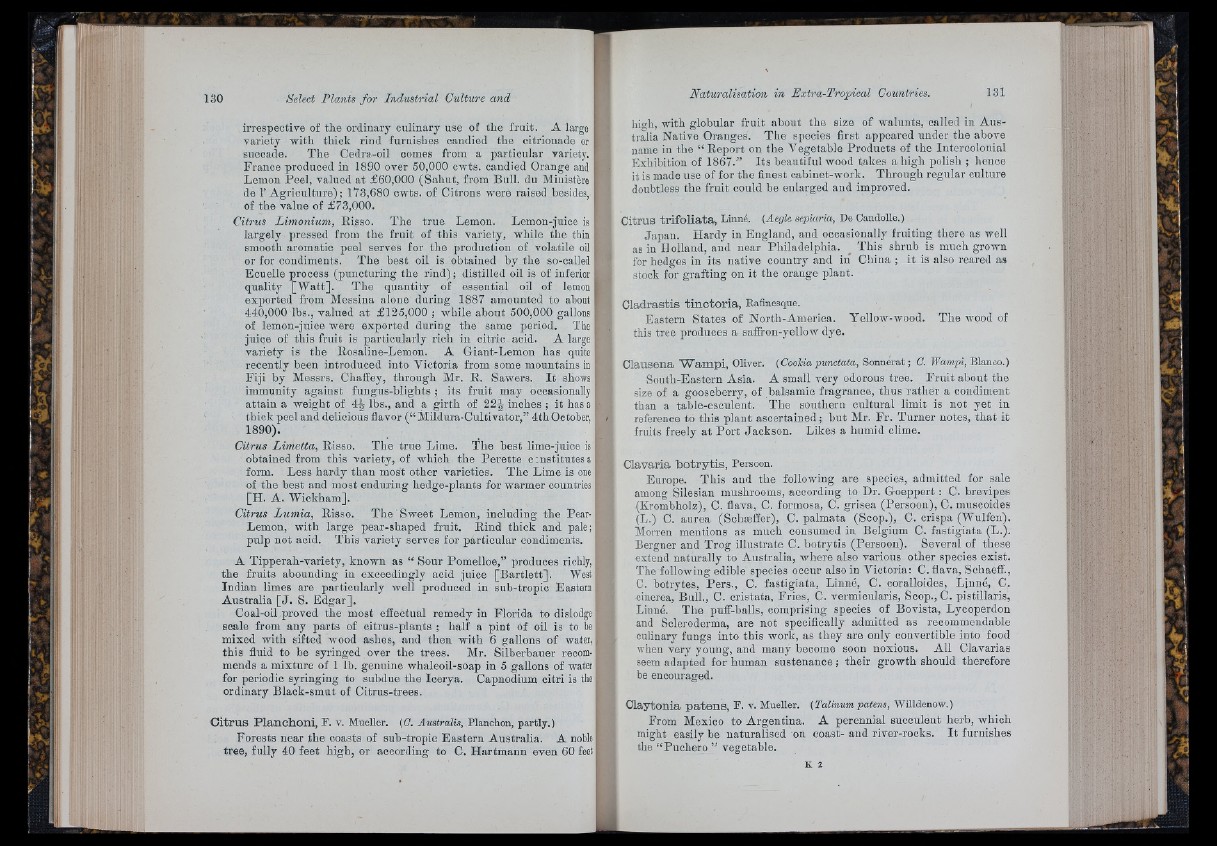
irrespective of the ordinary culinary use of the fruit. A largo
variety with thick rind furnishes candied the citrionade or
succade. The Cedra-oil comes from a particular variety,
France produced in 1890 over 50,000 cwts. candied Orange and
Lemon Peel, valued at £60,000 (Sahut, from Bull, du Ministère
de l’Agriculture); 173,680 cwts. of Citrons were raised besides,
of the value of £73,000.
Citrus Limonium, Risso. The true Lemon. Lemon-juioe is
largely pressed from the fruit of this variety, while the thin
smooth aromatic peel serves for the production of volatile oil
or for condiments. The best oil is obtained by the so-called
Ecuelle process (puncturing the rind) ; distilled oil is of inferior
quality [W a tt]. The quantity of essential oil of lemon
exported from Messina alone during 1887 amounted to about
440,000 Ibs.j valued a t £125,000 ; while abont 500,000 gallons
of lemon-juioe were exported during the same period. The
juice of this fruit is partioularly rich in citric acid. A large
variety is the Rosaline-Lemon. A Giant-Lemon has quite
recently been introduced into Victoria from some mountains in
Fiji by Messrs. ChaSey, through Mr. R. Sawers. I t shows
immunity against fungus-blights ; its fruit may occasionally
attain a weight of 4^ lbs., and a girth of 22J inches ; it has a
thick peel and delicious flavor (“ Mildura-Cultivator,” 4th October,
1890).
Citrus Limetta, Risso. The true Lime. The best lime-juice is
obtained from this variety, of which the P e re tte crnstitutesa
form. Less hardy than most other varieties. The Lime is one
of the best and most enduring hedge-plants for warmer countries
[H. A. Wickham],
Citrus Lumia, Risso. The Sweet Lemon, including the Pear-
Lemon, with large pear-shaped fruit. Rind thick and pale; ^
pulp not acid. This variety serves for particular condiments.
A Tipperah-variety, known as “ Sour Pomelloe,” produces richly,
the fruits abounding in exceedingly acid juice [B a rtle tt]. West
Indian limes are particularly well produced in sub-tropic Eastern
Australia [ J . S. Edgar],
Coal-oil proved the most effectual remedy in Florida to dislodge
scale from any parts of citrus-plants ; half a pint of oil is to be
mixed with sifted wood ashes, and then with 6 gallons of water, i,
this fluid to be syringed over the trees. Mr. Silberbauer recommends
for periodic syringing to subdue the Icerya. Capnodium citri is the j ordinary Black-smut of Citrus-trees, jt
a mixture of 1 ib. genuine whaleoil-soap in 5 gallons of water i
I
C itru s P la n c h o n i, F. V. Mueller. (C. Australis, Planchón, partly.) 'j
Forests near .the coasts of sub-tropic Eastern Australia. A noble :
tree, fully 40 feet high, or according to C. Hartmann even 60 feet i
Iflo-h, with globular fruit about the size of walunts, called in Australia
Native Oranges. The species first appeared under the above
ii.ame in the “ Report on the Vegetable Products of the Intercolonial
Exhibition of 1867.” Its beautiful wood takes a high polish ; hence
it is made use of for the finest cabinet-work. Through regular culture
doubtless the fruit could be enlarged and improved.
Citrus tr ifo lia ta , Linné. (AtgU sepiaria, De Candolle.)
Japan. Hardy in England, and occasionally fruiting there as well
as in Holland, and near Philadelphia. _ This shrub is much grown
for hedges in its native country and in China ; it is also reared as
stock for grafting on it the orange plant.
C lad rastis tin c to r ia , Eafinesque.
Eastern States of North-America. Yellow-wood,
this tree produces a saffron-yellow dye.
The wood of
Clausena ’W am p i, Oliver. {Coohiapunctata, Sonnerat ; C. Wampi,Hla.jico.)
South-Eastern Asia. A small very odorous tree. F ru it about the
size of a gooseberry, of balsamic fragrance, thus rather a condiment
than a table-esculent. The southern cultural limit is not yet in
reference to this plant ascertained ; hut Mr. Fr. Turner notes, th a t it
fruits freely a t P o rt Jackson. Likes a humid clime.
Clavaria b o try tis , Persoon.
Europe. This and the following are species, admitted for sale
among Silesian mushrooms, according to Dr. Goeppert : C. brevipes
(Krombholz), C. flava, C. formosa, C. grisea (Persoon), C. muscoides
(L.) C. aurea (Schælïer), C. palmata (Scop.), C. crispa (Wulfen).
Morren mentions as much consumed in Belgium C. fastigiata (L.).
Bergner and Trog illustrate C. botrytis (Persoon). Several of these
extend naturally to Australia, where also various other species exist.
The following edible species occur also in Victoria: C. flava, Schaeff.,
C. botrytes, Pers., C. fastigiata, Linné, C. coralloides, Linné, C.
cinerea, Bull., C. cristata. Fries, C. vermicularis. Scop., C. pistillaris,
Linné. The puff-balls, comprising species of Bovista, Lycoperdon
and Scleroderma, are not specifically admitted as reeommendable
culinary fungs into this work, as they are only convertible into food
when very young, and many become soon noxious. All Clavarias
seem adapted for human sustenance ; their growth should therefore
be encouraged.
Claytonia p a te n s , F. v. Mueller. (Talinumpatens, Willdenow.)
From Mexico to Argentina. A perennial succulent herb, which
might easily be naturalised on coast- aud river-rooks. I t furnishes
the “ Puohero ” vegetable.